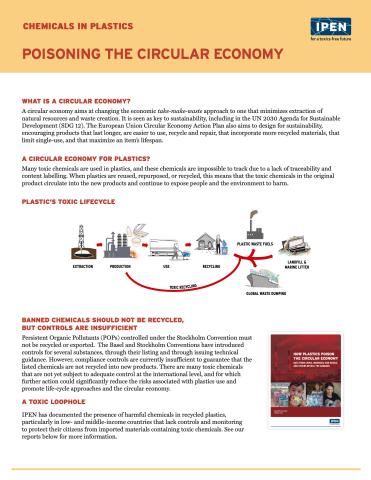Chemicals in Plastics: Poisoning the Circular Economy

What is a circular economy?
A circular economy aims at changing the economic take-make-waste approach to one that minimizes extraction of natural resources and waste creation. It is seen as key to sustainability, including in the UN 2030 Agenda for Sustainable Development (SDG 12). The European Union Circular Economy Action Plan also aims to design for sustainability, encouraging products that last longer, are easier to use, recycle and repair, that incorporate more recycled materials, that limit single-use, and that maximize an item’s lifespan.
A circular economy for plastics?
Many toxic chemicals are used in plastics, and these chemicals are impossible to track due to a lack of traceability and content labelling. When plastics are reused, repurposed, or recycled, this means that the toxic chemicals in the original product circulate into the new products and continue to expose people and the environment to harm.
Plastic’s toxic lifecycle
Banned chemicals should not be recycled, but controls are insufficient
Persistent Organic Pollutants (POPs) controlled under the Stockholm Convention must not be recycled or exported. The Basel and Stockholm Conventions have introduced controls for several substances, through their listing and through issuing technical guidance. However, compliance controls are currently insufficient to guarantee that the listed chemicals are not recycled into new products. There are many toxic chemicals that are not yet subject to adequate control at the international level, and for which further action could significantly reduce the risks associated with plastics use and promote life-cycle approaches and the circular economy.
A toxic loophole
IPEN has documented the presence of harmful chemicals in recycled plastics, particularly in low- and middle-income countries that lack controls and monitoring to protect their citizens from imported materials containing toxic chemicals. See our reports below for more information.
Read More about a Plastics Treaty
| Attachment | Size |
|---|---|
| 1.7 MB |

